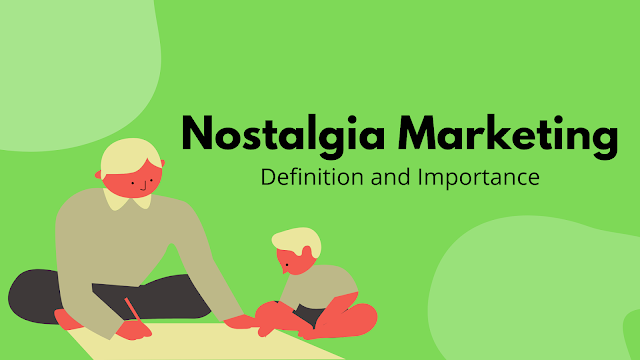The practise of harnessing positive and familiar concepts from previous decades to build trust in new ideas and active campaigns is known as "nostalgia marketing." In other words, it is a strategy to associate your business with something that people already enjoy and remember fondly.
Masks, social isolation, and working from home have spread this year. People are tired as a result of the lockdown and are looking for family entertainment options that bring back the fond memories of decades past. In fact, according to a recent survey, more than half of consumers find comfort in TV episodes, movies, and classic songs from their childhood.
But none of this should come as a surprise. Studies over the years have shown that homesickness can help people overcome boredom, loneliness, and anxiety. According to some research, it can even help people deal with major life transitions and stressful situations.
The joy of sketching campaign was wonderful since it not only capitalized on the advantages of nostalgia in advertising, but it also capitalized on current trends. The company even collaborated with Bob Ross Inc to ensure the accuracy of every aspect in the "Joy of Sketching" series.
2. Pepsi
To avoid being overtaken by its archrival, Coca-Cola, Pepsi has utilized nostalgia marketing as a means of attracting customers and creating emotional bonds. Pepsi, like Coca-Cola, brought back a discontinued beverage from the 1990s, "Crystal Pepsi," for a limited-time run in 2016. The brand used a series of great advertising efforts to advertise the forthcoming rebirth of the drink, which built on their previous nostalgic strategy.
One of the more appealing aspects of the campaign was a game dubbed the "Crystal Pepsi Trail," which was inspired by the 1970s' "Oregon Trail" game and updated with 90s references such as Tamagotchis and Furbies.
Pepsi has made a drink called "Pepsi Throwback," which is a version of the current beverage that uses cane sugar instead of high-fructose corn syrup and follows most of the formula from the 1980s.
3. Coca-Cola
Coca-Cola has long been portrayed as a nostalgic drink. Every year, we are treated to a dose of nostalgia in the shape of 1930s Christmas imagery. After Coca-Cola decided to discontinue its citrus-flavored drink "Surge" in 2014, three enthusiasts banded together to establish a petition demanding that it be reintroduced to stores.
Coca-Cola was delighted to oblige their customers by bringing a limited supply of Surge back to the United States, where it was sold exclusively on Amazon for a time before being disseminated out across the country in convenience stores. Because Cola didn't utilize nostalgic marketing to force an old idea on a new audience, the Surge relaunch was a hit. Instead, it merely replied to client demands in order to foster goodwill and loyalty among its supporters.
4. Apple
Apple may be the most popular technological business on the planet, and a large part of it may be ascribed to its brilliant marketing strategies. The firm is well-known for enlisting some of the world's most well-known celebrities in its advertising campaigns. However, the company improved their advertising in 2016 with a renewed emphasis in nostalgic marketing for the iPhone 6.
Apple enlisted the services of the Cookie Monster to create an ad that appealed to their audience's nostalgic side while also displaying a more fun and approachable aspect to their business. The technology company's nostalgia marketing effort could have been an attempt to remind customers that they're still capable of having fun, even if their main focus remains on developing new technologies.
In order to better engage customers, the ad's branding agency also published a funny sequence of "bloopers" aimed to capture the heartwarming emotion customers felt when seeing their favorite childhood figure on-screen.
5. Nintendo
The video game business could be one of the largest beneficiaries of nostalgia marketing's expanding popularity. Millennials are the generation that grew up playing games on Nintendo, Sony, and Sega systems, and they are also the generation that is most receptive to nostalgia in advertising. This could explain why Nintendo was so quick to capitalize on the nostalgia marketing technique by releasing a mini-NES with 30 games.
According to the company's president, the debut of the small NES was meant to give customers a chance to relive the reasons they fell in love with Nintendo at the start of their gaming careers. Although the NES classic edition isn't a perfect replica of the original, it's a terrific method to satisfy your nostalgic needs if you miss the games of the past and want to get away from the ever-changing market.
What does nostalgia mean in advertising?
Consumers are transported to a simpler age where advertisers use nostalgia marketing and products/services are viewed through this coloured lens. Even with an existing product, this type of marketing connects you to an earlier, recognizable era.
Why do millennials crave memories? Nostalgia in marketing
In an age that’s plagued by impersonal digital connections, nostalgia allows brands to leverage the optimistic feelings that come with a walk down memory lane. References to the past help to humanise brands.
Finally, nostalgia marketing efforts succeed because they evoke pleasant emotions and ideas from the past. Customers can use these tactics to revisit their favorite memories while avoiding the burden of duties and the chaos that surrounds us in the present.
The more positive our feelings are when we encounter a new or old brand, the more open we are to the company's messages. At the same time, we're more likely to act because nostalgia helps us feel something. Brands that employ creativity to create a "blast from the past" for their audience are more likely to connect with them on an emotional level, which is crucial for effective marketing.


Comments